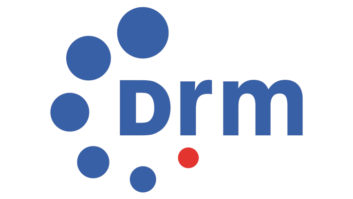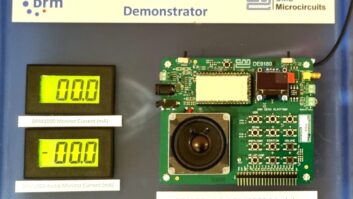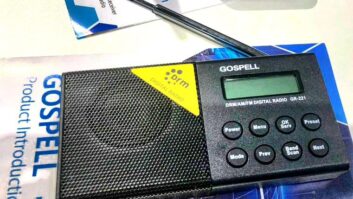CARY, N.C.
Adil Mina grew up in his native Lebanon listening to radio stations from around the world on a large shortwave radio, with all of the inherent static, fading and interference.
Eventually he would find himself working for Dallas-based Continental Electronics as vice president of business development. Mina is also chairman of the U.S. DRM Group.
Continental is an NASB member and manufacturer of shortwave transmitters. For the past 43 years he helped to design, build and commission many high-power medium-wave and shortwave transmitters and systems. Lately he has been traveling selling shortwave transmitters to religious, government and commercial stations globally.
Mina is a true believer in shortwave.
“I can really tell you that shortwave is alive and it is going forward,” he told the U.S. DRM annual meeting in Cary, N.C., in May. (Also see related stories in the July 2 issue of RW.)
He admits that sales have been a little slow during the past four or five years. “Except for some huge numbers of transmitters that have been sold to China during the period from 2000 to now, shortwave has been a little bit quiet, especially in the building of new stations.”
But he says that even with a worldwide recession, many international customers are still making plans to modernize and buy new transmitters.
Why is Mina bullish on shortwave?
(click thumbnail)Adil Mina with the author’s wife Thais. Photo by Jeff White“I once asked a friend from Saudi Arabia if he was going to put all of his programming on satellite. He said: ‘Mr. Mina, do I look that stupid? Do you think for one moment I would trust my broadcasting to anyone who controls a satellite or a local radio and who could shut me off at any moment they desire?’
“There’s what the beauty of shortwave is. Whatever your faith and your belief in shortwave is, it is justified. Shortwave — no matter how many other ways of broadcasting are invented in the world — DAB, DMB, DVD, whatever it is — is still the only medium that you can broadcast from your backyard to any country in the world.
“What’s happening today,” he said, “is that we finally realize that we, the technical people, should help you [the broadcasters] make that sound clear and make it practical. And that’s what DRM is all about.”
Two years behind
But Mina acknowledges DRM is not quite where it should be.
“I’ll be very honest about it,” he said. “DRM is about two years behind, in our opinion. It’s not because of transmitters or antennas or exciters. It’s because of the receivers.”
The DRM Consortium began 10 years ago. For that period, Deutsche Welle’s director of DRM, Peter Senger, has chaired the DRM consortium. Senger had been Deutsche Welle’s first chief engineer and later became DW’s director of distribution for its terrestrial and satellite networks.
Most DRM administrative responsibilities during this time have been centered at Deutsche Welle, but Senger had to retire in March due to German law, and his project director Anne Fechner also has retired.
The BBC stepped forward to take over the leadership of DRM. The controller of business development for BBC World Service, Ruxandra Obreja, is the new chairwoman of the DRM Consortium.
The BBC believes DRM has matured, according to Mina, which is why the broadcaster nominated a person with a business rather than technical background.
“Ruxandra, with her experience in business development, will do a great job in promoting DRM worldwide,” he said.
Until three and a half years ago, DRM was a digital system for long-wave, medium-wave and shortwave — up to 30 Megahertz. Then DRM+ was introduced.
Now DRM works with frequencies up to 108 MHz — basically FM, so theoretically, it could someday compete with FM IBOC, according to Mina.
Unfortunately, Mina points out, no transmitter manufacturer has yet made FM IBOC transmitters with DRM+, because, he believes, they have spent so much money developing IBOC transmitters.
As to the question of economical receivers and why they aren’t yet readily available: “Part of the reason,” said Mina, “is maybe we took our time on the standard, deciding what we want the receiver to do.”
Another reason is some manufacturers decided to wait to introduce a lower-cost DRM tuner until the DRM+ standard was set. There are DRM radios available from Roberts, Morphy Richards and Himalaya. However some of the tuners exhaust their batteries in six to eight hours, Mina said.
New DRM chips
But Mina is hopeful. A new consortium member, Analog Devices, introduced new DRM chips a few months ago, and a new receiver is expected to be built in India.
“We’ve seen the prototype,” said Mina. “They’re very encouraged. And we hope that we will have [a] $100 receiver.”
DRM Consortium members began talking about getting the receiver price down six years ago, he said. “There are receivers you can buy today for 200 Euros. The 200 figure we were hoping for six years ago is here, but it’s in Euros,” which was about $315 U.S. in June.
Mina is encouraged about a new tuner coming out of China. Thomson Broadcast found and worked with Dr. Lin Liang who founded a private company, Newstar Electronics; it plans to make DRM receivers. The design is being completed on what he called “very small” radios, he said.
The new Chinese receiver will have a small LCD screen, GPS, a built-in photo album and a DRM receiver.
Other DRM receivers are also being developed. Students at LeTourneau University in Longview, Texas, are working on a DRM unit, as are some three groups in China. There is also a group in South Africa developing a DRM receiver, specifically for use on shortwave, Mina said.
Last year at this convention there was hope that the Chinese would have DRM transmissions on air in time for the Olympics. “That’s not going to happen,” said Mina. “But eventually we will see DRM broadcasts in China.”
China is buying DRM-ready transmitters, he said. “China uses shortwave to talk to their own people. Because of that, they will go to DRM to cover their own territory. People in rural China need shortwave.”
He predicted low-cost DRM receivers would “soon” be on the market.
Mina said most shortwave transmitters bought during the last 20 years that have solid-state modulators are ready for DRM with a minor modification and new exciter. Older transmitters with high-level plate modulation can be modified for DRM. “We have done many of them. We just finished one in Saipan.”
Although DRM isn’t being used on medium-wave in the United States, there have been successful medium-wave simulcast tests in Mexico, Brazil and India, according to the consortium. There are also regular DRM broadcasts on medium-wave from several European broadcasters.
If you order a new shortwave transmitter today from companies like Continental, there’s no extra cost for DRM capability; it’s built in. If you need a DRM exciter for an existing transmitter, it’s a slightly different story. “Our exciters are still a little bit too expensive,” said Mina. But he noted prices have dropped and said that HCJB World Radio is trying to develop a lower-cost DRM exciter.
Mina said prices are still a bit prohibitive for most potential 26 MHz DRM operations. A TCI study showed that a 200-watt AM transmitter could cover the San Francisco Bay Area with one antenna, providing the FCC would license it.
“But exciters are still 40,000 to 50,000 Euros,” he lamented, which is roughly $62,000 to $78,000 U.S. “That is discouraging.” In contrast, IBOC exciters cost about $20,000 he said.













